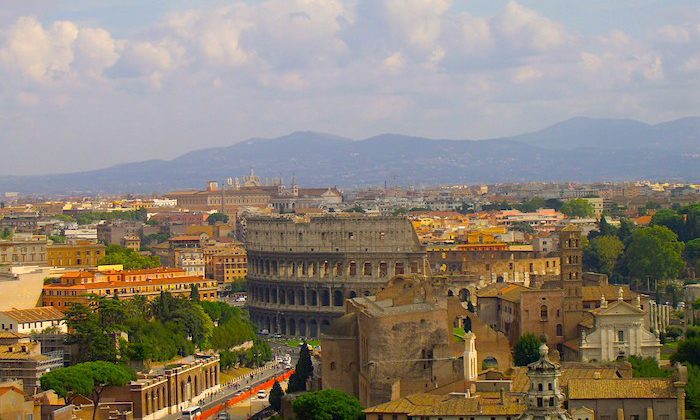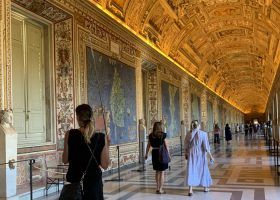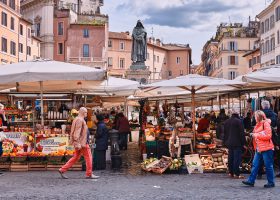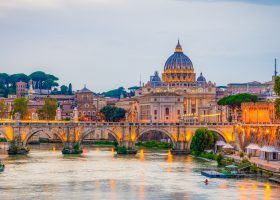Planning to spend time in the central Piazza Venezia of Rome and want to know what there is to see? You’ve come to the right place. In this article, discover the top things you should check out near Piazza Venezia.
Pro Tip: Planning what to do on your trip to Rome? Bookmark this post in your browser so you can easily find it when you’re in the city. See our guide to Rome for more resources to help you plan your trip. Also, check out our best Rome tours so you can see the Eternal City right.
What To See Near Piazza Venezia
Piazza Venezia is the center of Rome and the point where many of Rome’s main roads connect. This main intersection of the city connects you to all the top things to do in Rome, but there are loads of things to do in this very Piazza—it’s action-packed! Here are the top things to see near Piazza Venezia, plus restaurant recommendations.
1. Altare della Patria
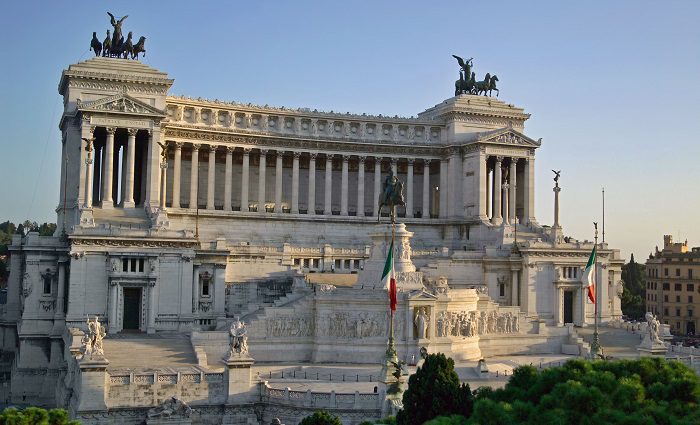
The Altare della Patria, also known as “the big white Piazza Venezia building” or ” Vittoriano” is one of Rome’s largest and most famous monuments. The name translates to Alter of the Fatherland.
This refers to the great unification of Italy under its first of two kings, Victor Emmanuel II of the Savoia Family. The monument is dedicated to him for unifying Italy in 1861—1871. Yep, Italy is pretty new. Originally, the country was divided into kingdoms like that of Milan, Venice, Florence, or Naples, for example. Now it is one country united.
The official name of the structure is the Victor Emmanuel II Monument or Vittoriano in Italian but it is often referred to as the Altare della Patria, which refers to a shrine with a burning flame, that of ancient Rome, dedicated to the unknown soldier. It has also been referred to as the Italian Wedding Cake since it looks like a massive wedding cake.
The building has been heavily associated with Fascism since Piazza Venezia was the location Mussolini chose for many of his parades and speeches. All fascist symbols have been removed from the structure and square. However, many locals in Rome spoke of the building as a beautiful structure but a reminder of recent Italian failures. The structure points to Rome’s ancient history because the city has had so few victories in the last hundred or so years.
The Monument
That said, I think it’s a pretty impressive structure architecturally. Victor Emmanuel II is featured in the center on horseback. He is flanked and framed on either side by propylaea, which are greek style gateways. On the very top of each stands a massive four-horse-drawn chariot (quadriga) pulling winged Victoria. Victoria is the Greek goddess Nike and represents victory.
The idea of the monument is simultaneously simple and complex. Italy, a now unified nation, can leave behind the victories of Ancient Rome and the control of the Papal State to form a new Italian Rennaissance. Something that locals feel has not been accomplished but they are in fact very wrong.
While the government has had difficulties, the unified nation has accomplished far more than people speak about in the last 100 years. The phrase “made in Italy” is synonymous with high-quality craftsmanship. That feeds into many sectors from textiles to cars and fashion. Speaking of which, many of the world’s premier fashion houses hail from Italy.
Personally, I think the building is beautiful and iconic—one of the many great landmarks in Rome. It also has a really great feature, the elevator (up next), which gets you to a terrace with fantastic views.
Address: Piazza Venezia
2. Panoramic Terrace
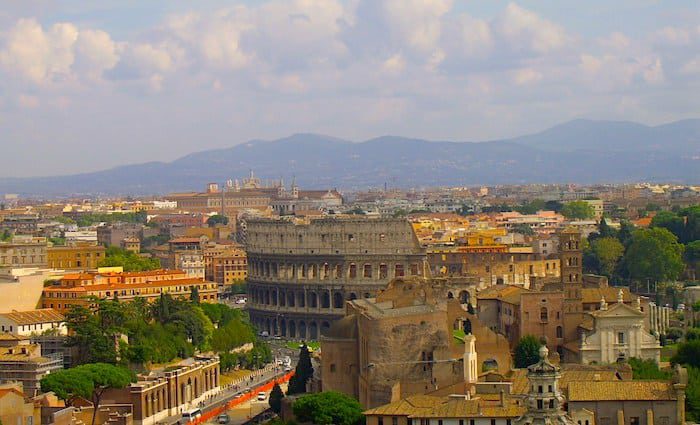
Quite possibly the best view of Rome, the panoramic terrace on top of the Vittoriano is a pretty cool experience for anyone visiting Rome with an extra hour in their schedule and €10 in their pocket.
Getting to the terrace is pretty easy and you don’t have to enter the monument/museum to access the elevator. The elevator is surprisingly empty as nobody really knows it exists. Enter the front gates of the monument and head up the steps. While looking at the monument, keep right and walk around to the back of the building. Once at the back, you’ll see a large glass elevator. Take the elevator and enjoy the views.
Address: Altare della Patria | Hours: Daily, 9:30 am – 7:30 pm (last entrance 6:45 pm).
3. Trajan’s Column
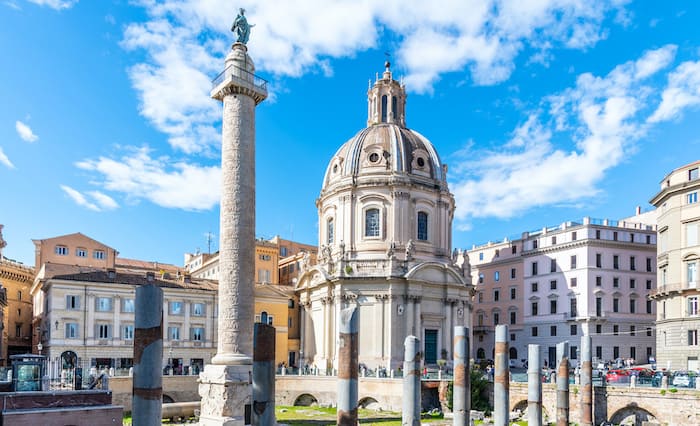
Trajan’s column is an incredible monument and surviving piece of propaganda from the second century A.D. The column has an incredible history and plays a very important role in our ability to put together ancient timelines. The column, built in approximately A.D. 113, is 114 feet tall (35 meters) and honors Emperor Trajan for his conquests in Dacia, modern-day Romania. It is located in Trajan’s Forum, also dedicated to the late emperor.
It is an incredible feat of engineering by none other than Apollodorus of Damascus—one of the most influential architects of all time. He can take credit for two of the best-preserved buildings in Rome. The structure is built of 20 massive Carrara marble cylinders stacked on top of a base.
The column is wrapped with a helical frieze that winds 23 times around the column and features 2,662 figures depicting 155 stories or scenes. An impressive feature of the column is its hollowed-out center containing a staircase that winds all the way to the top. Today, you’ll find a statue of St. Peter on top. Previously, the figure of Trajan sat on top until it was removed by the church and replaced with St. Peter.
The symbolism goes deeper still. Trajan’s Forum is home to Trajan’s market, which was a multi-level market that featured luxury apartments at its center. Romans, it seems, wanted the same material stuff we do. Before the market was built in this location, there was a massive 114-foot hill. So, Trajan built a massive phallic symbol the size as the hill it replaced with him on top—amazing.
Address: Via dei Fori Imperiali
4. Trajan’s Market
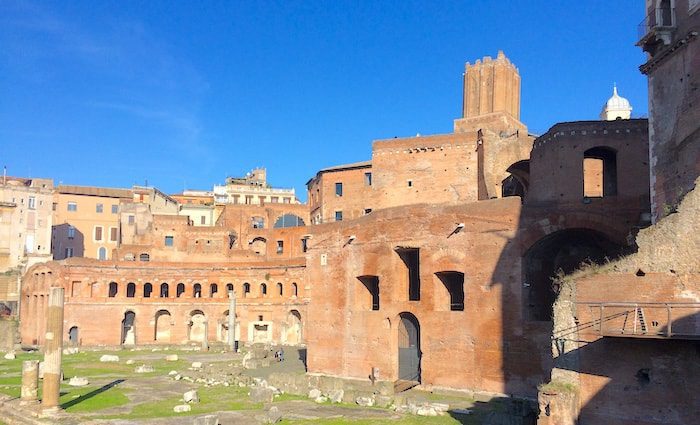
It’s said that Trajan’s Market, built around A.D. 100, is the world’s first covered shopping mall. A prominent landmark and a symbol of imperial power since A.D. 113, Trajan’s Column in Rome was a focal point of the great forum and market complex built by Emperor Trajan on the north side of the Roman Forum.
The arcades in Trajan’s Market are thought by many to have been Emperor Trajan’s administrative offices. It’s still possible to visit several levels of the multi-level structure. Highlights of Trajan’s Market include the remains of a library and delicate marble floors. This is also the location of the Museo dei Fori Imperiali. Go beyond the Colosseum and visit this place too.
Address: Via Quattro Novembre, 94 | Hours: Daily, 9:30 am to 7:30 pm
5. Palazzo di Venezia
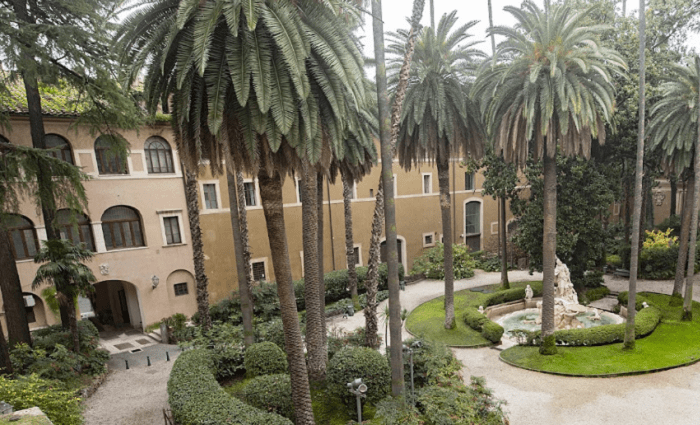
Palazzo Venezia is one of my favorite monuments in all of Rome for reasons that go beyond the lack-luster facade or the infamous Mussolini balcony, but we should get them out of the way.
While the structure feels like it is in Piazza Venezia, the front is actually in the adjacent Piazza S. Marco. The structure is a brick and stone building that has origins all the way back to A.D. 336. There have been numerous improvements over time, turning the building into more of the complex it is today.
What is truly interesting is the purpose of this building. A major restoration took place in the late 15th century when the building functioned as a papal residence for a short period. Eventually, it was given to the Kingdom of Venice as a gift, which is likely when the neighboring piazza took the name Piazza San Marco.
It then became the Venetian Embassy to Rome. Yes, Venice had an embassy in Rome. Italy was not a unified country from the time of the fall of the Roman Empire in the 5th century A.D. up until the late 19th century. Rome was controlled by the Papal State and sometimes the kingdoms got along and other times they were at war. You can visit the inside of the palace—the interior courtyard is very peaceful and you won’t find any crowds.
Address: Via del Plebiscito, 118
6. Napoleon Balcony
If you look at the building on the left-hand corner of Via del Corso and Piazza Venezia, you can look up to the top terrace and see the word “Bonaparte” written on the top. After Napoleon I was exiled to the Island of Elba in 1814, his mother Letizia Bonaparte managed to strike a deal with Pope Pius VII to grant her asylum in Rome.
Napoleon managed to escape Elba and head back to France where he would reign again, but only for a few months. His mother stayed in Rome despite Napoleon’s continued escapades. She lived there until her death in 1836 outliving her son by 15 years. She was 85 when she died.
Address: Piazza Venezia, 5
Popular Tours from Rome
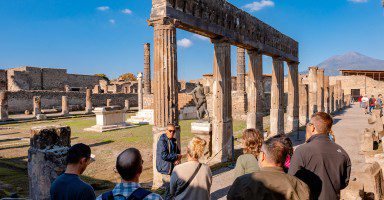
Best Seller
Unforgettable Rome Day Trip to Pompeii and Sorrento
Making a day trip from Rome to Pompeii and the Amalfi Coast can be daunting, with long travel times, complex routes, and tricky logistics to manage. Our full-day tour eliminates the stress, offering comfortbale transport straight to Pompeii. With an archaeologist guide, explore the ancient ruins without the hassle. Then, unwind with free time in Sorrento’s coastal charm. Led by a local guide and small group, this trip makes experiencing Italy’s highlights easy and enjoyable—all in one day.
See prices and more info
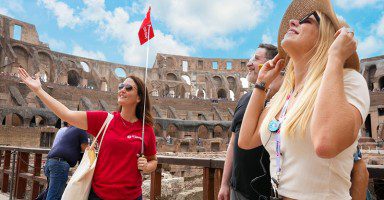
Best Seller
Rome in a Day Tour with Colosseum & Vatican Museums
Seeing the best of Rome in a single day might seem like a big undertaking, but our expertly designed tour makes it effortless with skip-the-line tickets, included transportation, and engaging guides to lead the way. In just 7 hours, you’ll visit renowned sites like the Sistine Chapel, Colosseum, Trevi Fountain, and Pantheon. With fascinating stories at every stop, you can skip the stress and immerse yourself in the vibrant heritage and culture of Rome all in one remarkable day.
See prices and more info
Not ready to book a tour? Check out our Rome Guide for more info.
7. Five-Story Ancient Roman Apartments
The word insula in Latin translates to “island” but the Romans used this word for their apartment buildings. If you take the road on the right-hand side while facing the Vittoriano, you’ll see a pair of staircases. One is La Cordonata and the other leads to the Church of S. M. d’Aracoeli. Just before the first staircase, you’ll see a brick structure that was discovered in 1927.
This second-century structure was once a five-story apartment building for residential housing. The first three stories were single-unit shops. The fourth story was likely slave housing and the fifth would have been an aristocratic apartment with luxuries similar to today.
Other than 20th-century housing upgrades like airconditioning, not much has changed. We use mostly the same building materials. Apartments were made of brick and wood. Plaster could be added to those surfaces for decoration and walls were often painted. Running water was a feature for the wealthy—not in multiple rooms like today but many palaces had numerous fountains. Forced air (heating) was even a feature for the super-wealthy as it was on the Palatine Hill. The main thing they lacked was electricity.
Address: Piazza d’Aracoeli, 1
8. La Cordonata
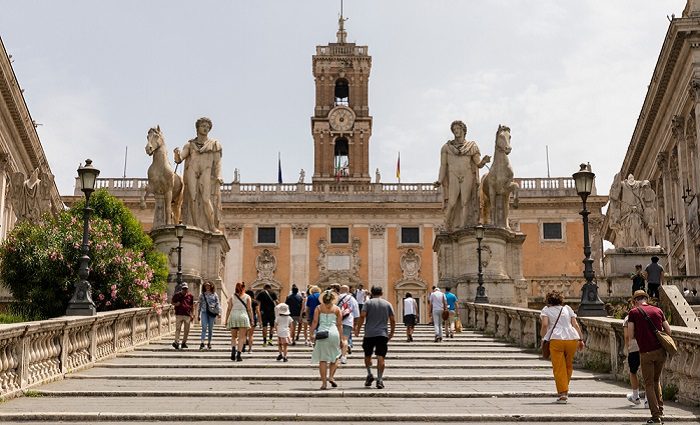
This great sloping ramp (not a staircase) was planned out by Michelangelo himself and built by Giacomo della Porta in 1582. The goal was simple: build a staircase that a horse and carriage could go up. La cordonata was designed so statesmen and officials could ride up to the top of Piazza del Campidoglio (Capitoline Hill) where local government was run.
On either side of the ramp, you’ll see two massive figures, the brothers. These are demi-gods Castor and Pollux with their horses. They were found in 1561 near the Temple of Castor and Pollux in the Roman Forum and reconstructed to line the steps. You can read more about their story in our article about what to see in the Roman Forum.
Many other statues were re-erected and placed around the city in places they otherwise don’t belong. The idea was to beautify the city by using past relics and it worked!
Address: Piazza del Campidoglio
9. Capitoline Hill
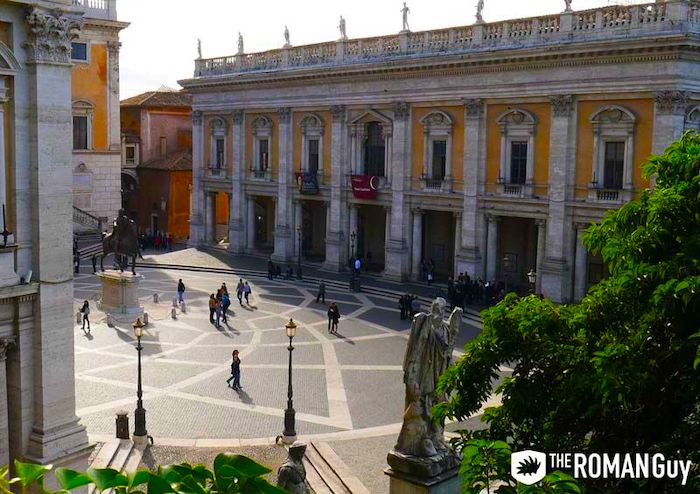
Also known as Piazza Campidoglio, Capitoline Hill is the area where the Capitoline Museum sits atop the foundation of the Temple of Jupiter. As you get to the top of the steps you’ll see three buildings that comprise the Capitoline Museum, listed below.
Directly in the center, you’ll see a copy of the equestrian statue of Marcus Aurelius. He rides on horseback to show his military prowess and features a beard to symbolize that he was a scholar. This is a copy of an original that is inside Palazzo dei Conservatori Museum.
Behind him, you’ll see two more large men reclined and semi-nude holding cornucopia. They have long beards and are both river gods. On the left, you’ll find the Nile. On the right, the Tiber. They were taken from the Baths of Constantine to decorate the area. Between the two, you’ll find the goddess Roma.
Address: Capitoline Hill
10. Capitoline Hill Viewpoint Overlooking Forum
Just behind the Palazzo dei Conservatori, the central building, there is an incredible and free viewpoint overlooking the Forum. When standing next to the equestrian statue of Marcus Aurelius, look to the right of Palazzo dei Conservatori and you’ll see a small street that looks like you may not be allowed to go down it. The street is named Via del Campidoglio and you are allowed to go down it.
Turn left when you see the incredible view of the Forum! If you’d like to go a little further, walk up to see the Tarpeian Rock. Take the high road from the viewpoint up the hill. This steep cliff/rock was an execution site in Roman times. The cliff is about 25 meters high (80 feet) and was used to execute many guilty and probably not-so-guilty people in antiquity.
Address: Via Monte Tarpeo, 42 | Tarpeian Rock
11. Capitoline Museum
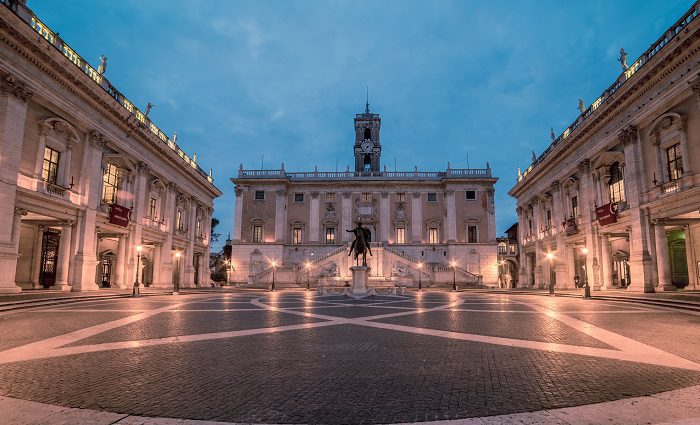
The Capitoline Museum or Musei Capitolini is definitely the full package. The theme of the museum is ancient history, which is befitting as it sits on the outer edge of the Roman Forum with one of the best views.
The museum is split up into three buildings: Palazzo Senatorio, built in the 12th century, updated by Michelangelo himself, and overlooking the forum; Palazzo dei Conservatori, built in the 16th century and also redesigned by Michelangelo; and Palazzo Nuovo, which was built in the 17th century and sits directly across from Palazzo Conservatori with an identical exterior design.
Michelangelo had a massive impact on the exterior appeal of this museum complex. He not only designed the format of these museums but also the stairs leading up to Piazza Campidoglio—la Cordonata. Here is a short list of what you need to see when visiting this monumental museum:
- La Cordonata
- Piazza Campidoglio
- View of the Roman Forum from the back of Palazzo Senetorio
- The Dying Gaul
- Head of the Colossal Statue of Constantine I
- Eros Thanatos
- Bust of Augustus
- Commodus as Hercules (gotta love Commodus)
- Heracles Fighting
- Triton
- The Pinario
- Baby Hercules Strangling a Snake
- Capitoline Wolf
- Bernini’s Medusa
- Statue of Horti Lamiani
- Cupid & Psyche
- Statue of Emperor Marcus Aurelius (most notable attraction)
Address: Piazza del Campidoglio, 1| Admission Cost: €11.50 + Exhibition fee (€3 – €4 extra, which varies)
12. Teatro Marcello
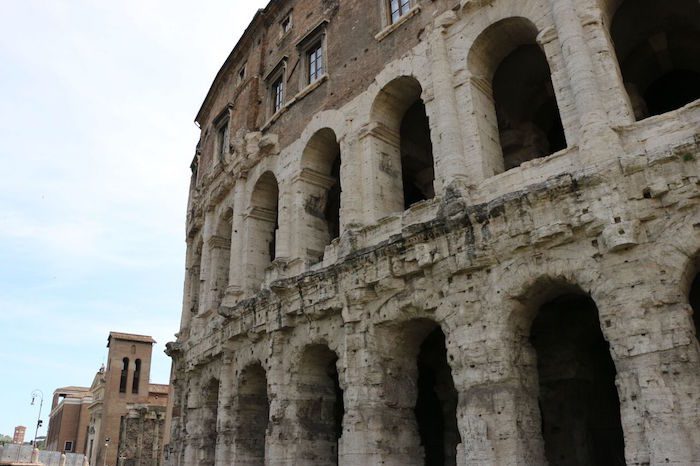
The Theatre of Marcellus in Rome is an ancient open-air theatre that existed even before the Colosseum. It was built in about 13 B.C. but was not used for gladiatorial events. Romans were both savages and patrons of the arts all in the same day.
You could sit with up to 20,000 other spectators and watch theatre or musical events here. It was inaugurated by Augustus in the name of his son Marcus Claudius who died at a young age.
One of my favorite things about this structure is its modern use. The theatre was bought by the Orsini family in the 16th century and became their residence. The noble family was formed in the 12th century and their name lives on today. The current living descendant of the household is Prince Lelio Orsini d’Aragona.
Address: Via del Teatro di Marcello
Next Stop…
If you’re doing a walking tour of Rome, your next stop should be The Trevi Fountain and you should already have explored Piazza del Popolo and nearby.
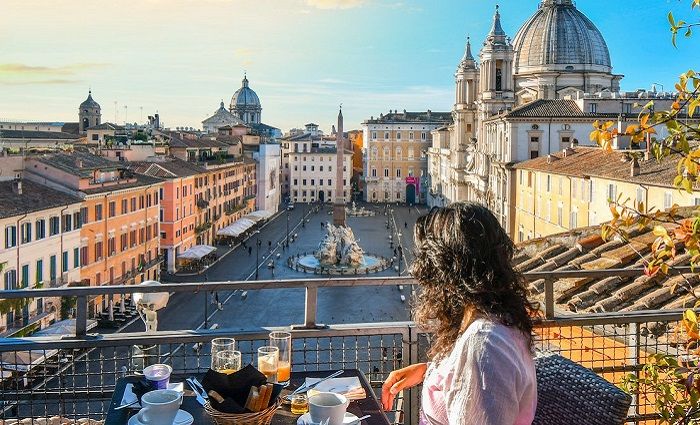
Where To Stay in Rome
Rome has a rich cultural history and many iconic landmarks to explore. Plan where to stay in the magnificent Eternal City in the best neighborhoods.

